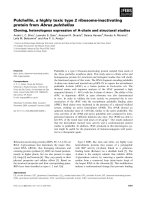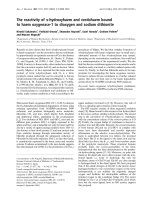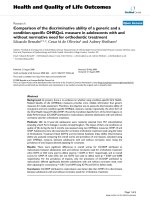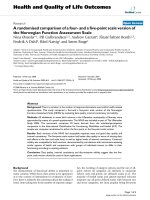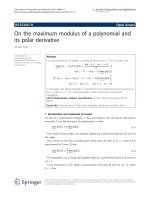Building the tree of life reconstructing the evolution of a recent and megadiverse branch (calyptrates diptera)
Bạn đang xem bản rút gọn của tài liệu. Xem và tải ngay bản đầy đủ của tài liệu tại đây (6.53 MB, 201 trang )
BUILDING THE TREE OF LIFE: RECONSTRUCTING THE
EVOLUTION OF A RECENT AND MEGADIVERSE BRANCH
(CALYPTRATAE: DIPTERA)
SUJATHA NARAYANAN KUTTY
(B.Tech)
A THESIS SUBMITTED FOR THE DEGREE OF
DOCTOR OF PHILOSOPHY
DEPARTMENT OF BIOLOGICAL SCIENCES
NATIONAL UNIVERSITY OF SINGAPORE
2008
ii
The great tragedy of Science - the slaying of a beautiful hypothesis by an ugly fact. -
Thomas H. Huxley
i
ACKNOWLEDGEMENTS
We don't accomplish anything in this world alone and whatever happens is the result of the
whole tapestry of one's life and all the weavings of individual threads from one to another that
creates something - Sandra Day O'Connor.
The completion of this project would have been impossible without help from so many
different quarters and the few lines of gratitude and acknowledgements written out in this
section would do no justice to the actual amount of support and encouragement that I
have received and that has contributed to making this study a successful endeavor.
I am indebted to Prof. Meier for motivating me to embark on my PhD (at a very
confusing point for me) and giving me a chance to explore a field that was quite novel to
me. I express my sincere gratitude to him for all the guidance, timely advice, pep talks,
and support through all the stages of this project and for always being patient while
dealing with my ignorance. He has also been very understanding during all my non-
academic distractions in the last two years. Thanks Prof your motivation and
inspiration in the five years of my graduate study has given me the confidence to push the
boundaries of my own capabilities. You should be acknowledged as the best supervisor
one can have.
I would also like to thank Dr. Thomas Pape for sending large amounts of specimens all of
which have been invaluable for this study and for all his timely inputs, immaculate proof
reading and important suggestions at various junctures of the project. I would also like to
ii
thank Dr. Brian Wiegmann and his lab members especially Brain Cassel for my
enriching stint at NCSU, Raleigh. Special thanks to Dr. Frederik Petersen, Dr. Adrian
Pont, Dr. Marco Bernasconi
and Dr. František Šifner for all their important and useful
inputs in this study. I also thank all other collaborators who have directly and indirectly
contributed to this study.
I would like to thank Kathy, my first labbie along with whom I figured out the tricks of
pcr-ing and Nalini for all the unwinding sessions and especially for her support and
‘motivation’ during the last phase of thesis writing. Thanks girls for not just being such
wonderful colleagues but also lovely friends with whom I have spent some of the best
times in evolab.
Thanks to all the other members of the evolab (past and current) who have helped and
supported me at different stages and many of whom I have seen begin and finish their
projects during these years: Gaurav, Shiyang, Gwynne, Guanyang, Weisong, Yuchen,
Farhan, Danwei, Denise, Dave, Nanthinee, Zeehan, Martin, Mirza, WaiKit and Huifung.
Thanks Anu, Aparna, Nilofer and Rika for all the fun times, get-togethers and of course
the brilliant dance sessions.
Thanks to Suni for being my support system for almost a decade now, Janesh for always
sticking by my side, Ettan, Chechi and Vishu for being my family away from home and my
iii
friends on the other side of the globe who have ‘virtually’ always supported me- Pavan
and Venky.
I have to thank Acha, Amma and Sumi, my ‘perfect’ family for pitching in whichever way
they could, and my extended family especially my darling Meena and also my new family
(in-law).
Lastly and most importantly - Sunil, who switched roles from being the ‘crazy’ guy in my
world to my fiancée and finally to my better half, all during the course of this
dissertation. In your own quiet way, you have always been my pillar of strength and
constant source of support over the years. Thank you so much for understanding and
putting up with my daily crankiness, random cooking patterns and the late night writing
sessions for the last couple of months. I owe you one!
iv
TABLE OF CONTENTS
Acknowledgements i
Table of contents iv
Summary ix
List of Tables xi
List of Figures xii
List of Publications xv
Introduction 1
Chapter 1: Phylogeny and evolution of host choice in the Hippoboscoidea
(Diptera) as reconstructed using four molecular markers
1.1 Introduction 7
1.1.1
Family portraits: Biology and Systematics
8
1.1.2
Hippoboscoidea Phylogenetics
11
1.2 Materials and Methods 14
1.2.1
Taxon sampling, DNA extraction and sequencing
14
1.2.2
Phylogenetic Analysis
17
1.3 Results 19
1.4 Discussion 23
1.4.1
Classificatory implications
26
1.4.2
Host-shifts and diversification in Hippoboscoidea
28
1.4.3
Morphological and life history evolution in Hippoboscoidea
32
1.5 Conclusions 34
v
Chapter 2: Sensitivity analysis, molecular systematics, and natural history
evolution of Scathophagidae (Diptera:Cyclorrhapha:Calyptratae)
2.1 Introduction 36
2.1.1
Comparing alignment techniques
38
through a sensitivity analysis
2.2 Materials and Methods 40
2.2.1
Taxa and DNA extractions
40
2.2.2
DNA amplification and sequencing
40
2.2.3
Tree search strategies
42
2.2.4
Sensitivity analysis
43
2.2.5
Natural history
44
2.3 Results 49
2.3.1
Alignment techniques, indel treatment, character
49
transformation weighting
2.4 Discussion 56
2.4.1
Sensitivity analyses and Choice of alignment
56
2.4.2
Node support and Node stability
60
2.4.3
Systematic conclusions
61
2.4.4
Natural history evolution
64
2.5 Conclusions 68
vi
Chapter 3: The Muscoidea (Diptera: Calyptratae) are paraphyletic: Evidence
from four mitochondrial and four nuclear genes
3.1 Introduction 70
3.1.1
Fanniidae
71
3.1.2
Muscidae
72
3.1.3
Anthomyiidae
73
3.1.4
Scathophagidae
74
3.1.5
Interfamilial relationships
75
3.2 Materials and Methods 77
3.2.1
Taxa and DNA extractions
77
3.2.2
DNA amplification
77
3.2.3
Alignments
81
3.2.4
Tree search strategies
82
3.3 Results 83
3.3.1
Alignment techniques, indel treatment, character
transformation weighting
3.4 Discussion 90
3.4.1
Comparison of tree hypotheses
91
3.4.2
Calyptrate monophyly
92
3.4.3
Superfamily monophyly and the relationships
92
between the calyptrate superfamilies
3.4.4
Interfamilial relationships within the muscoid grade
94
3.4.5
Family monophyly and relationships within families
95
3.4.6
Alignments of the ribosomal genes
98
3.5 Conclusions 108
vii
Chapter 4: Molecular phylogeny of the Calyptratae (Diptera:Cyclorrhapha)
with emphasis on the Oestroidea
4.1 Introduction 110
4.1.1
Oestroidea phylogenetics
111
4.1.2
Oestroidea family relationships
111
4.1.3
Oestroidea family portraits
113
4.1.4
Is the McAlpine’s fly a calyptrate?
120
4.1.5
Calyptratae phylogenetics
121
4.2 Materials and Methods 126
4.2.1
Taxa
126
4.2.2
DNA extractions
127
4.2.3
DNA amplification and sequencing
134
4.2.4
Alignments
135
4.2.5
Taxa selection strategy for analysis
136
4.2.6
Tree search strategies
137
4.3 Results 138
4.4 Discussion 147
4.4.1
Oestroidea monophyly
148
4.4.2
Placement of the McAlpine’s fly and M. zelandica in the
148
Oestroidea
4.4.3 Oestroidea family relationships 149
4.4.4 Higher-level systematics of the Calyptratae
152
4.5 Conclusions 155
viii
Overall conclusions 156
References 159
ix
SUMMARY
The Calyptratae (Cyclorrhapha: Schizhophora) consists of about 18,000 described
species representing about 12% of Diptera diversity. Traditionally, the Calyptratae were
divided into three superfamilies,
viz
. the Hippoboscoidea, Muscoidea and the
Oestroidea. In this study, 1.14 million base pairs of data from eight genes for 258
species and this molecular data are used to reconstruct the relationships within the
Calyptratae.
In the first chapter, the phylogenetic relationships within the superfamily Hippoboscoidea
are reconstructed using maximum parsimony and Bayesian methods based on
nucleotide sequences from four genes: 28S, CAD, and 16S and COI. Most of the
presently recognized groups within Hippoboscoidea, including the superfamily as a
whole, the Hippoboscidae and the Nycteribiidae are recovered as monophyletic. A single
shift from a free-living fly to a blood-feeding ectoparasite of vertebrates is confirmed and
at least two host shifts from mammals to birds have occurred.
The 60,000 described species of Cyclorrhapha are characterized by an unusual diversity
in larval life history traits, which range from saprophagy over phytophagy to parasitism
and predation. In the second chapter, the Scathophagidae, a relatively small muscoid
family that mirrors this diversity in natural history strategies is used for reconstructing the
direction of change of larval habits in the group. The molecular data set utilizes data from
seven genes (12S, 16S, Cytb, COI, 28S, Ef1-alpha, Pol II) and was subjected to an
extensive sensitivity analysis and the performance of three different alignment strategies
x
(manual, Clustal, POY) was compared. Phytophagy in the form of leaf mining is shown
to be the ancestral larval feeding habit for Scathophagidae. From phytophagy, two shifts
to saprophagy and one shift to predation have occurred while a second origin of
predation is from a saprophagous ancestor. The monophyly of the Scathophagidae, its
two constituent subfamilies, and most genera are confirmed.
The reconstruction of the Muscoidea relationships in Chapter 3 demonstrates paraphyly.
The Muscoidea comprises with approximately 7,000 described species a significant
portion of the species-level Diptera diversity (ca. 5%). In this chapter, four mitochondrial
genes (12S, 16S, COI, Cytb), and four nuclear genes (18S, 28S, Ef1a, CAD) are used to
reconstruct the relationships within the Muscoidea using both maximum parsimony and
likelihood techniques. The Muscoidea are paraphyletic with a monophyletic Oestroidea
being nested within the muscoid grade. The monophyly of three (the Fanniidae,
Muscidae, and Scathophagidae) of the four recognized families is confirmed while the
Anthomyiidae is apparently paraphyletic.
The fourth chapter concentrates on the Oestroidea, but it also includes the data from the
previous chapters. Overall, the relationships between 247 calyptrate species
representing all three superfamilies are reconstructed using molecular data from both
mitochondrial (12S, 16S, COI, Cytb) and nuclear genes (18S, 28S, Ef1a and CAD). The
monophyly of the Calyptratae, the superfamilies Hippoboscoidea and Oestroidea and the
paraphyly of the muscoid grade are confirmed. A first comprehensive family-level
hypothesis for the Oestroidea is proposed and the positions of two enigmatic species,
the McAlpine’s fly and
Mysctacinobia zelandica
are clarified.
xi
LIST OF TABLES
TABLE
NO.
DESCRIPTION
PAGE NO.
1.1
Species list and GenBank accession numbers.
16
1.2
Primer sequences used for PCR amplification and sequencing
(1 primer for initial amplification; 2 primer for reamplification).
17
1.3
Testing competing phylogenetic hypotheses for
Hippoboscoidea using the Templeton test (z-test; *=difference
between topologies is significant).
24
2.1
Taxa used in study and known larval breeding habits
45
2.2
Primers used in study
48
2.3
Summary of jackknife support, ILD and symmetric tree
distances for different partitions of the dataset from the various
analyses using different weighting regimes for different
alignment strategies and treatment of gaps as missing or
information
55
3.1
List of taxa used in study with Genbank accession numbers
(gixxx = submitted to Genbank).
78
4.1
Species used in study with total length (bp) and genes
amplified.
128
4.2
Primers used in study
135
xii
LIST OF FIGURES
FIGURE
NO.
DESCRIPTION
PAGE
NO.
1.1
Previously proposed phylogenetic relationships within the
Hippoboscoidea. OWS = Old World Streblidae; NWS – New World
Streblidae
13
1.2
Figure 1. 2A: Maximum parsimony tree based on combined
sequence data from CAD, COI, 16s and 28s (numbers in first line
are bootstrap support values and posterior probabilities; - =
bootstrap support < 50; numbers in second line are PBS values for
CAD/COI/16s/28s; 1= Olfersini; 2= Hippoboscinae; 3=Lipopteninae;
4=Ornithomyini).
Fig. 1.2 B: Subtree illustrating the topological difference between
most parsimonious tree s with and without
Brachytarsina speiseri
(numbers = bootstrap support).
Fig. 1.2 C: Subtree illustrating the topological difference between
the most parsimonious tree in 2A and and the Bayesian tree
(numbers = posterior probabilities).
22
1.3
Key events in the evolution of the Hippoboscoidea.
31
2.1
Most parsimonious tree for all manual alignments and indel
treatments under optimal analysis conditions (tv=4). Support values
are indicated on branches as Jackknife support. The set of
numbers toward the bottom of the squares represent the [transition,
transversion, gap] costs used for the particular analysis. Black
fields in the sensitivity plot signify agreement, white disagreement,
and grey neither (polytomy).
52
xiii
FIGURE
NO.
DESCRIPTION
PAGE
NO.
2.2
Most parsimonious tree for direct optimization (in POY) under
optimal analysis conditions (tv=4). Support values are indicated
on branches as Jackknife support. The set of numbers to the
bottom of each of the squares represent the [transition,
transversion, gap] costs used for the particular analysis. Black
fields in the sensitivity plot signify agreement, white
disagreement, and grey neither (polytomy).
53
2.3
Most pasimonious tree under equal weighting using a manual
alignment
54
2.4
Number of times a node is recovered out of the ten different
analysis conditions (nodal stability) under manual alignment (•)
and direct optimization alignments () versus Jackknife support at
the node.
61
2.5
Tracing of natural history evolution in the Scathophagidae. One of
the optimizations when phytophagy is coded separately as dicot
and monocot (represented by symbols) is shown here. In this
case, the Scathophagid ancestor was feeding on monocot plants.
Taxa for which there is either species-specific information or at
least statements about the genus have been included.
65
3.1
Strict consensus of three most parsimonious trees (indel=5th
character); above node jackknife support for indel=5
th
character
state; below node indel=missing; nodes shared with ML tree
indicated by.
86
3.2
Likelihood tree from ML analysis (Garli) indicating bootstrap
support, nodes shared with selected guide tree indicated by
and majority rule consensus of all ten guide trees indicated by.
88
xiv
FIGURE
NO.
DESCRIPTION
PAGE
NO.
3.3
12s guide tree from Clustal X.
100
3.4
16s guide tree from Clustal X.
101
3.5
28s guide tree from Clustal X.
102
3.6
18s guide tree from Clustal X.
103
3.7
Guide tree from Clustal X used in alignment of ribosomal genes.
104
3.8
Strict consensus of 23 most parsimonious trees (indel=missing).
105
3.9
Majority rule consensus of trees from parsimony analysis of
datasets based on the ten different guide trees.
106
4.1
Two different hypotheses for the family relationships within the
Oestroidea based on morphology a) McAlpine (1989) b) Pape
(1992).
113
4.2
Phylogeny of the Calyptratae based on morphology in McAlpine,
1989.
125
4.3
Strict consensus of fifteen most parsimonious trees (indel=5th
character); value above node jackknife support for indel=5th
character state; below node indel=missing.
139
4.4
Likelihood tree from Maximum likelihood analysis using Garli
143
xv
LIST OF PUBLICATIONS
1. Kutty, S.N., Bernasconi, M.V., Sifner, F., Meier, R., 2007. Sensitivity analysis,
molecular systematics and natural history evolution of Scathophagidae
(Diptera: Cyclorrhapha : Calyptratae). Cladistics 23, 64-83.
2. Kutty, S.N., Pape, T., Pont, A.C., Wiegmann, B.M., Meier, R. The Muscoidea
(Diptera: Calyptratae) are paraphyletic: Evidence from four mitochondrial and
four nuclear genes. Molecular Phylogenetics and Evolution. 49, 639-652.
3. Petersen, F.T., Meier, R., Kutty, S.N., Wiegmann, B.M., 2007. The phylogeny
and evolution of host choice in the Hippoboscoidea (Diptera) as reconstructed
using four molecular markers. Mol. Phylogenet. Evol. 45, 111-122.
4. Su, K.F.Y., Kutty, S.N., Meier, R., 2008. Morphology versus Molecules: The
phylogenetic relationships of Sepsidae (Diptera: Cyclorrhapha) based on
morphology and DNA sequence data from ten genes. Cladistics. 24, 902-916.
5. Tan, S.H.D., Ali, F., Kutty, S. N., Meier, R. The need for specifying species
concepts: how many species of silvered langurs (Trachypithecus cristatus
group) should be recognized? Mol. Phylogenet. Evol. 49, 688-689.
6. Puniamoorthy, N., Jeevanandam, J., Kutty, S.N., 2008. Give south Indian
authors their true names. Nature 452, 530-530.
7. Lim, S.G, Hwang, W. S., Kutty, S. N., Meier, R. and Grootaert, P., 2009.
Mitochondrial and nuclear markers support the monophyly of Dolichopodidae
and suggest a rapid origin of the subfamilies (Diptera: Empidoidea). Sys.
Entomology. Accepted.
1
INTRODUCTION
The concept of “Tree–of-Life” is one of main elements of Charles Darwin’s theory of
evolution according to which the evolutionary relationships of the earth’s biodiversity,
including all living and extinct forms over the past 3.5 billion years, can be depicted
by a tree-like diagram. Having a tree-of-life for all species is important for modern
biology because it provides the framework for all comparative biology. It reveals how
the diversity evolved as well as the historical basis for similarity and differences
among organisms (AToL, 2004). Building this Tree of Life is one of the most complex
scientific problems facing modern biology because the number of species that are
described and yet to be discovered is vast and a large amount of data has already
been published. This includes the morphology of recent and extinct species,
developmental data, behavior, etc. for many of these species. All this information has
to be collected and new analytic tools are needed to reconstruct the relationships
based on these data. This is the main goal of the US National Science Foundation
funded project ‘Assembling the Tree of Life’ which involves many international teams
that concentrate on different subsets of taxa. Obtaining an accurate and universal
‘Tree of Life’ has enormous research potentials and benefits to society by improving
human health, improving agriculture, tracing developmental changes, protecting
invasive species form ecosystems and also understating disease out breaks and
evolution of strains (AToL, 2004).
With an estimated 150,000 described species, the insect order Diptera (Class
Insecta, Phylum Arthropoda), or true flies is one of the most diverse branch on the
Tree of Life (FLYTREE, 2006). Diptera is also is one of the four “megadiverse” orders
of insects. As many flies are of economic and medical importance and are also
2
model organisms for research, understanding the relationships between the different
fly clades is important. This is why the FLYTREE project was funded as part of the
NSF sponsored ‘Assembling the Tree of Life’ initiative. FLYTREE is an international
research collaboration designed to elaborate and discover the details of fly
relationships and diversity with the ultimate goal of providing a newly resolved
phylogeny for this major branch of the Tree of Life (FLYTREE 2006). The most
effective way of transmitting new phylogenetic evidence is via a published data
matrix analyzed in a quantitative framework (Yeates and Wiegmann, 1999) and the
FLYTREE project is an ambitious endeavor that will be carried out in a three-tier
approach with each tier tackling different Diptera relationships at different levels.
Eventually these data will be combined to build a meta-analysis based tree with 2000
species. The Diptera comprise 10% of all described animal species and FLYTREE is
thus a major part of the Tree of Life project. Within Diptera, one major clade is the
Calyptratae, the subject of my PhD project.
The Calyptratae comprises about 18,000 described species representing 12% of
dipteran diversity which forms a sizeable part of the Diptera diversity. The commonly
known members of this group are house flies, blowflies, flesh-flies, tsetse flies,
warble flies, etc and many species have close associations with humans, livestock
and agriculture. Despite its medical and economic importance, the relationships
within the calyptrates are very poorly understood and most literature on the
phylogeny of the group (Hennig, 1973; McAlpine, 1989; Pape, 1992; Nirmala, 2001;
etc.) is often controversial. The Calyptratae are morphologically and biologically very
diverse and have invaded a large variety of habitats. They show an exceptional
range of natural history traits. However, despite all this diversity, the clade appears to
be relatively young with the oldest confirmed fossil being only 40 million years old.
3
Although phylogenetic studies, mostly based on morphological data, have been
carried out for a few families and subfamilies of the group, a phylogenetic tree for the
Calyptratae is not available. At the onset of my thesis, I assessed what is known
based on the available data. The reconstruction of phylogenies of large groups like
the Calyptratae can be approached by either using the supermatrix method or the
supertree method (Sanderson et al., 1998). I combined all the available data for
species under study into a single matrix and used the information from each
character directly in the supermatrix analysis. The trees from the different published
studies are recoded in a matrix format and then combined using the MRP (Matrix
representation with parsimony) technique in the supertree approach. The trees
obtained by both approaches were poorly resolved in conflict and it became clear
that new data were needed. Since the data overlap of both genes and taxa in the
available datasets was poor, adding more data into a supermatrix of taxa from across
the calyptrate group was regarded as the most appropriate approach. This is the
technique that I have used for this project.
OBJECTIVES
My PhD project aims to resolve phylogenetic relationships in the group Calyptratae
using molecular data. The general objectives are to address:
i. monophyly and relationships between superfamilies.
ii. monophyly and relationships between the recognized families (Glossinidae,
Hippoboscidae, Streblidae, Nycteribiidae, Fanniidae, Musciidae,
Anthomyiidae, Scathophagidae, Calliphoridae, Oestridae, Tachinidae,
Rhinophoridae, Sarcophagidae, Mystaciinobiidae).
iii. position of the enigmatic species referred to as “McAlpine’s fly”.
4
iv. evolution of life history strategies like host choice and larval breeding habits
within the group.
v. the performance of various alignment and test various analyses techniques
using the calyptrate dataset.
I approached this large and ambitious PhD project by subdividing the Calyptratae into
smaller taxa. Three of the thesis chapters are thus based on the currently recognized
three superfamilies (Hippoboscoidea, Muscoidea and Oestroidea) and one chapter is
a detailed phylogenetic study on the family Scathophagidae (Calyptrate: Muscoidea):
Chapter 1: The phylogeny and evolution of host choice in the Hippoboscoidea
(Diptera) as reconstructed using four molecular markers.
Chapter 2: Sensitivity analysis, molecular systematics, and natural history
evolution of Scathophagidae (Diptera:Calyptrate: Musocidea).
Chapter 3: The Muscoidea (Diptera:Calyptratae) are paraphyletic: Evidence from
four mitochondrial and four nuclear genes.
Chapter 4: Molecular phylogeny of the Calyptratae (Diptera:Cyclorrhapha) with
emphasis on the Oestroidea.
The sequence of the chapters in the dissertation reflects how the project evolved
which explains why different analysis and alignment techniques were tested in the
different sections. Alignment techniques used in this project are 1) Clustal
(Thompson et al., 1994), 2) Manual alignment based on Clustal alignments, 3) Direct
optimization (Wheeler, 1996), and 4) user alignments based on user-defined guide
trees (Kumar and Filipski, 2007). The data were analyzed using 1) Parsimony
executed PAUP* (Swofford, 2002) and TNT (Goloboff et al., 2000) 2) Maximum
5
Likelihood as implemented in Garli (Zwickl, 2006) and 3) Bayesian likelihood
(Huelsenbeck and Ronquist 2003). The variation in alignments and analyses
between chapters reflects progress in the field during the duration of the PhD. Some
analysis techniques that yielded poor results were also not applied in subsequent
analyses. Some analyses technique could also not be used in the final chapter
because the dataset was too large for the available computational resources.
This dissertation is my original work but like any project; this study and all resulting
publications are a result of a collaborative effort and to give due credit to all involved
“we” has been used throughout this dissertation.
CHAPTER 1
The phylogeny and evolution of host choice in
the Hippoboscoidea (Diptera) as reconstructed
using four molecular markers
7
1.1 INTRODUCTION
Hippoboscoidea are highly specialized ectoparasitic flies with four recognized family-
level taxa: Glossinidae, Hippoboscidae, Streblidae, and Nycteribiidae (Hennig, 1973;
McAlpine, 1989; but see Griffiths, 1972). The well-known Glossinidae (tsetse flies)
are free-living and only come into close contact with their host during feeding. The
other three families, Hippoboscidae, Nycteribiidae, and Streblidae, are all genuine
ectoparasites (i.e. species with a trophic and a spatial association to a host)
spending all or most of their adult life within the fur or among the feathers of their
mammal and bird hosts. These families exhibit a large number of unique and striking
morphological and physiological adaptations, most of which are specifically
associated with their ectoparasitic lifestyle. One of the most remarkable of these is
adenotrophic viviparity (Meier et al., 1999). The larvae develop individually, in the
female oviduct, where they are fed by secretions from accessory glands. The fully
mature 3
rd
instar larva is deposited either as a motile larva, which quickly pupates
within its last larval skin (Glossinidae, Hippoboscidae), or as a more or less soft pre-
puparium (Streblidae, Nycteribiidae). At the time of deposition, the weight of the larva
can exceed the weight of the female (Hill, 1963).
Although the group has received considerable taxonomic attention, comparatively
little is known about the relationships among the families. As a consequence,
phylogenetic assessments of the evolution of host choice have not yet been possible
and much of the literature on the subject is highly speculative. A recently published
molecular systematic analysis by Dittmar et al. (2006) addressed some of these
problems, but it focused largely on the relationships within Streblidae and
Nycteribiidae, and included only a few species from the remaining families. Here, we
8
present results from a complementary phylogenetic study that includes a broader
taxon sample from the Hippoboscidae and Glossinidae and we explore the use of
different genetic markers than those used in Dittmar et al. (2006). In addition to the
mitochondrial 16S rDNA used by Dittmar et al (2006), we sequenced fragments of
the nuclear genes 28S ribosomal DNA (28S rDNA), the carbamoyl-phosphate
synthase (CPSase) domain of CAD (Moulton and Wiegmann, 2004), and the
mitochondrial gene cytochrome oxidase I (COI), for 35 species. The goal of the
current study was to test the monophyly of the Hippoboscoidea, test the monophyly
of the four subordinate families, clarify the phylogenetic relationships among the
families, and to use the resulting trees to reconstruct key events in the evolution of
Hippoboscoidea.
1.1.1
Family portraits: Biology and Systematics
Nycteribiidae are obligate ectoparasites of bats with highly specialized and reduced
adult morphology. The wings are completely reduced, the thorax is dorsoventrally
flattened, the legs are inserted dorsally, and the head is folded backwards resting on
the thorax. The flies thus have a spider-like appearance and are regularly delivered
to spider taxonomists for identification (N. Scharff, pers. comm.). The adults spend all
of their life in the fur of the host, leaving the host only for brief periods in order to affix
a puparium to the wall or ceiling of the bat roost. Numerous morphological
synapomorphies have left little doubt that the Nycteribiidae are monophyletic
(Hennig, 1973). Three subfamilies are recognized: the Archinycteribiinae and
Cyclopodiinae (on Megachiroptera), and the Nycteribiinae (on Microchiroptera;
Hennig, 1973; Theodor, 1967). Morphological support for this subdivision comes
mainly from the number of tergites on the female abdomen, the position of the
thoracic sutures and setae, shape of tibiae, and overall chaetotaxy. However, these



